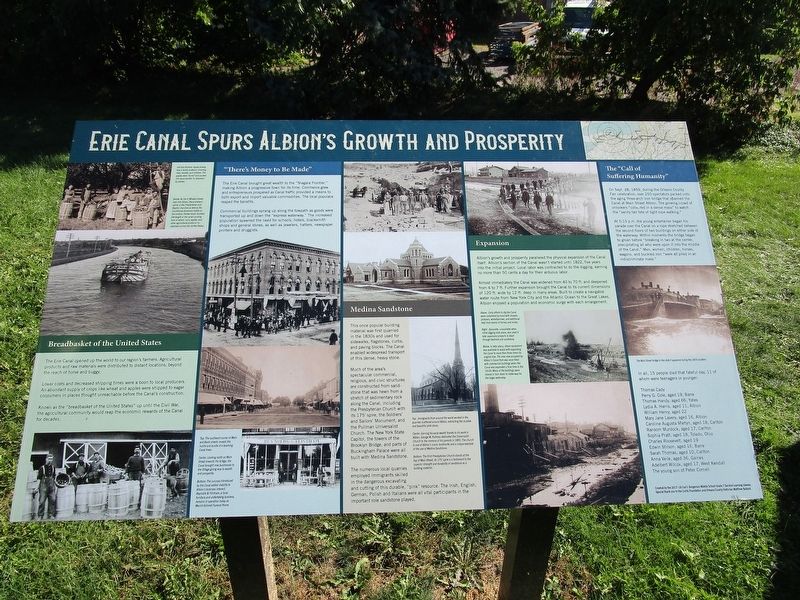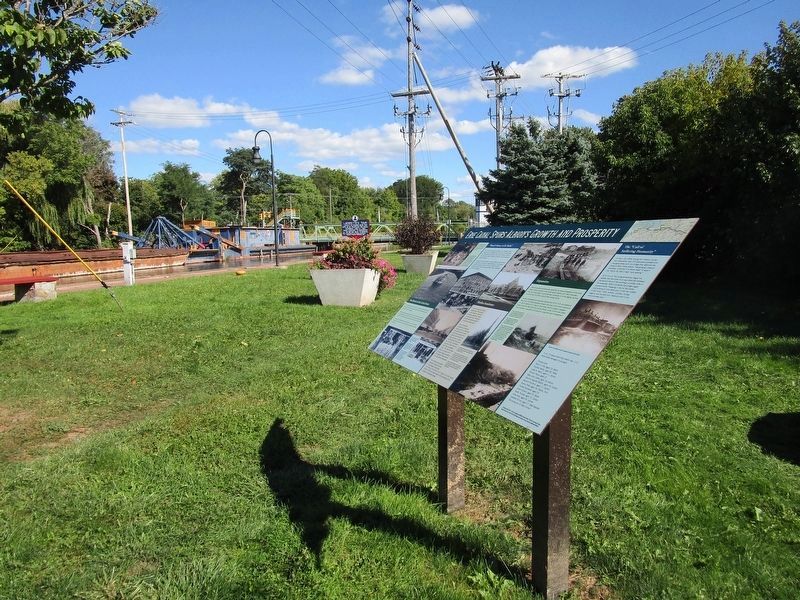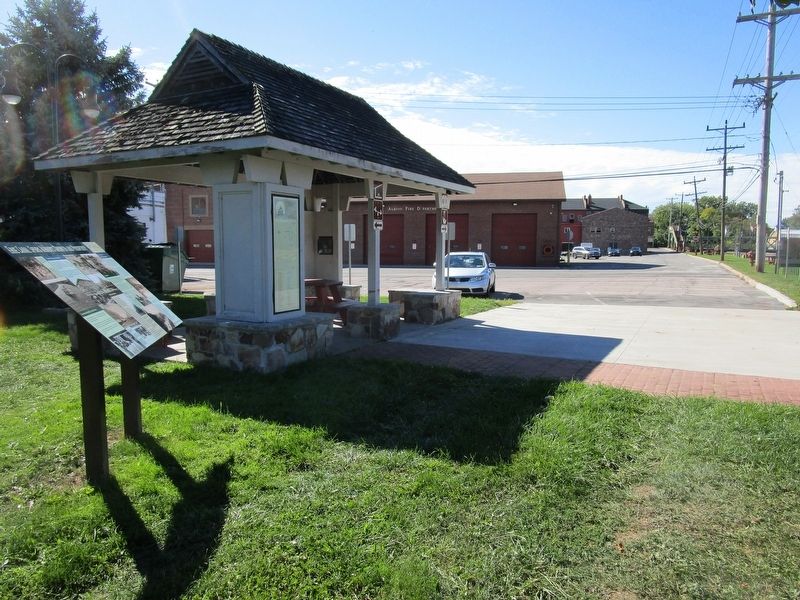Albion in Orleans County, New York — The American Northeast (Mid-Atlantic)
Erie Canal Spurs Albion's Growth and Prosperity
Inscription.
Breadbasket of the United States: The Erie Canal opened up the world to our region’s farmers. Agricultural products and raw materials were distributed to distant locations, beyond the reach of horse and buggy.
Lower costs and decreased shipping times were a boon to local producers. An abundant supply of crops like wheat and apples were shipped to eager consumers in places thought unreachable before the Canal’s construction.
Known as the “breadbasket of the United States” up until the Civil War, the agricultural community would reap the economic rewards of the Canal for decades.
Left and Bottom: Apple picking was a family endeavor involving men, women, and children. The apples were “faces” and packed into wood barrels for shipment by packet.
Below: As the A. Whalen travels east into Albion, the prominent spires of the presbyterian and Baptist churches as well as the Courthouse dome are visible on the horizon. Packet boats traveled the length of the canal carrying tons of wheat, corn, apples, and other agricultural products for shipment across the United States.
“There’s Money to Be Made”: the Erie Canal brought great wealth to the “Niagara Frontier,” making Albion a progressive town for its time. Commerce grew and entrepreneurs prospered as Canal traffic provided a means to both export and import valuable commodities. The local populace reaped the benefits.
Commerical buildings sprang up along the towpath as goods were transported up and down the “express waterway.” The increased population spawned the need for schools, hotels, blacksmith shops and general stores, as well as jewelers, hatters, newspaper printers and druggists.
Top: The southeast corner of Main and Bank streets reveals the hustle and bustle of a booming Canal town.
Center: Looking north on Main Street towards the bridge, the Canal brought new businesses to the Village giving way to wealth and prosperity.
Bottom: The success introduced by the Canal added stability to Albion’s business interest. Reynolds & Flintham, a local furniture and undertaking business, remains in operation today as Merrill-Grinnell Funeral Home.
Medina Sandstone: This once popular building material was first quarried in the 1830s and used for sidewalks, flagstones, curbs, and paving blocks. The Canal enabled widespread transport of this dense, heavy stone.
Much of the area’s spectacular commercial, religious, and civic structures are constructed from sandstone that was hewn from a stretch of sedimentary rock along the Canal, including the Presbyterian Church with its 175’ spire, the Soldiers’ and Sailors’ Monument, and the Pullman Universalist Church. The New York State
Capitol, the towers of the Brooklyn Bridge, and parts of Buckingham Palace were all built with Medina Sandstone.
The numerous local quarries employed immigrants skilled in the dangerous excavating and cutting of this durable, “pink” resource. The Irish, English, German, Polish and Italians were all vital participants in the important role sandstone played.
Top: Immigrants from around the world worked in the quarries scattered around Albion, extracting the durable and beautiful pink stone.
Center: Earning his early wealth thanks to his work in Albion, George M. Pullman dedicated the Universalist Church to the memory of his parents in 1895. The church is one of Albion’s iconic landmarks and a unique example of the use of Medina Sandstone.
Bottom: The First Presbyterian Church stands at the top of Main Street, its 175’ spire is a testament to the superior strength and durability of sandstone as a building material.
Expansion: Albion’s growth and prosperity paralleled the physical expansion of the Canal itself. Albion’s section of the Canal wasn’t started until 1822, five years into the initial project. Local labor was contracted to do the digging, earning no more than 50 cents a day for their arduous labor.
Almost immediately the Canal was widened from 40 to 70 ft. and deepened from 4 to 7ft. Further expansion brought the Canal
to its current dimensions of 120 ft. wide by 12 ft. deep in many areas. Built to create a navigable water route from New York City and the Atlantic Ocean to the Great Lakes, Albion enjoyed a population and economic surge with each enlargement.
Above: Early efforts to dig the Canal were completed by hand with shovels, pickaxes, wheelbarrows, and additional help from teams of horses and mules.
Right: Dynamite, unavailable when initial digging took place, was used in later expansion projects to blast through bedrock and sandstone.
Below: In later years, steam equipment was available to assist with expanding the Canal to more than three times its original size. The area now occupied by Albion’s Cana; Park was once filled with commercial buildings when the Canal was expanded a final time in the 1910s. Many of the buildings were moved or torn down to make way for the larger waterway.
The “Call of Suffering Humanity”: On Sept. 28, 1859, during the Orleans County Fair celebration, over 250 spectators packed onto the aging three-arch iron bridge that spanned the Canal at Main Street Albion. The growing crowd of onlookers “collected in a dense mass” to watch the “vanity fair fete of tight rope walking.”
At 5:15 p.m. the young entertainer began his parade over the Canal on a rope stretched between the second floors of two buildings on either side of the waterway. Within moments the bridge began to groan before “breaking in two at the center, precipitating all who were upon it into the middle of the Canal.” Men, women, children, horses, wagons, and buckled iron “were all piled in an indiscriminate mass.”
In all, 15 people died the fateful day, 11 of whom were teenagers or younger: Thomas Cady; Perry G. Cole, aged 19, Barre; Thomas Handy, aged 66, Yates; Lydia A. Harris, aged 11, Albion; William Henry, aged 22; Mary Jane Lavery, aged 16, Albion; Caroline Augusta Martyn, aged 18, Carlton; Ransom Murdock, aged 17, Carlton; Sophia Pratt aged 18, Toledo, Ohio; Charles Roosevelt, aged 19; Edwin Stilson, aged 16, Barre; Sarah Thomas, aged 10, Carlton; Anna Veile, aged 36, Gaines; Adelbert Wilcox, Aged 17, West Kendall; The young son of Peter Cornell
The Main Street bridge in the style it appeared during the 1859 accident.
Erected 2018 by Carl I. Berguson Middle School Serviec Learning Classes, Curtis Foundation, Orleans County Historian.
Topics and series. This historical marker is listed in these topic lists: Agriculture • Disasters • Industry & Commerce • Waterways & Vessels. In addition, it is included in the Erie Canal series list. A significant historical year for this entry is 1822.
Location. 43° 14.913′ N, 78° 11.505′ W. Marker is in Albion, New York, in Orleans County. Marker is on North Platt Street, 0.1 miles north of East Bank Street, on the right when traveling north. Touch for map. Marker is in this post office area: Albion NY 14411, United States of America. Touch for directions.
Other nearby markers. At least 8 other markers are within walking distance of this marker. Lafayette's Tour (a few steps from this marker); Erie Canal 1825 (about 400 feet away, measured in a direct line); Historic Downtown Albion (about 500 feet away); Calamity Sept. 28, 1859 (about 600 feet away); Home of Sanford E. Church (about 800 feet away); First United Methodist Church (about 800 feet away); Hitching Posts (approx. 0.2 miles away); Irish, English, Italian and Polish Immigrants (approx. 0.2 miles away). Touch for a list and map of all markers in Albion.
Credits. This page was last revised on September 24, 2022. It was originally submitted on September 24, 2022, by Anton Schwarzmueller of Wilson, New York. This page has been viewed 108 times since then and 12 times this year. Photos: 1, 2, 3. submitted on September 24, 2022, by Anton Schwarzmueller of Wilson, New York.


